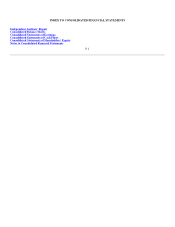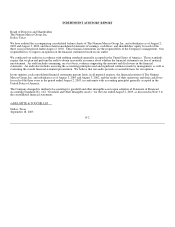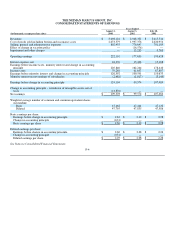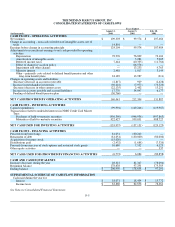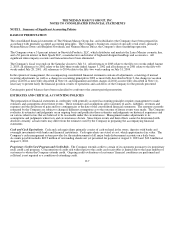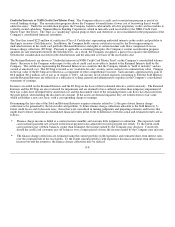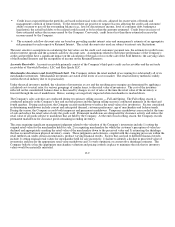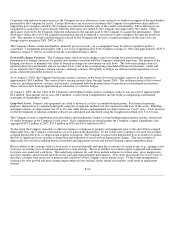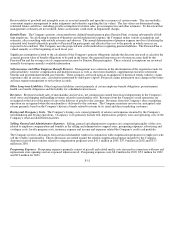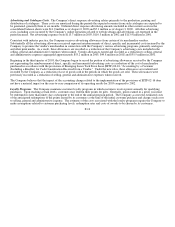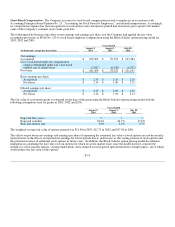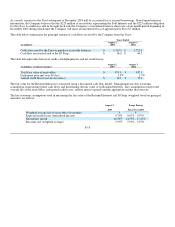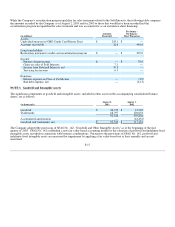Neiman Marcus 2002 Annual Report Download - page 44
Download and view the complete annual report
Please find page 44 of the 2002 Neiman Marcus annual report below. You can navigate through the pages in the report by either clicking on the pages listed below, or by using the keyword search tool below to find specific information within the annual report.
Consistent with industry business practice, the Company receives allowances from certain of its vendors in support of the merchandise
purchased by the Company for resale. Certain allowances are received to reimburse the Company for markdowns taken and/or to
support the gross margins earned by the Company in connection with the sales of the vendor's merchandise. These allowances are
recognized as an increase to gross margin when the allowances are earned by the Company and approved by the vendor. Other
allowances received by the Company represent reductions to the amounts paid by the Company to acquire the merchandise. These
allowances reduce the cost of the acquired merchandise and are recognized as an increase to gross margin at the time the goods are
sold. The amounts of vendor reimbursements received by the Company did not have a significant impact on the year-over-year
change in gross margin in 2003, 2002 or 2001.
The Company obtains certain merchandise, primarily precious jewelry, on a consignment basis in order to expand its product
assortment. Consignment merchandise with a cost basis of approximately $214.0 million at August 2, 2003 and approximately $233.0
million at August 3, 2002 is not reflected in the consolidated balance sheets.
Forward Exchange Contracts. The Company enters into forward exchange contracts to hedge forecasted inventory purchases
denominated in foreign currencies for periods and amounts consistent with the Company's identified exposures. The purpose of the
hedging activities is to minimize the effect of foreign exchange rate movements on cash flows. The forward exchange contracts
represent derivative instruments and are recorded at fair value in the accompanying consolidated financial statements. Gains and
losses related to the Company's foreign currency exchange contracts that qualify as hedges are deferred and recognized in cost of
goods sold in the period the inventory is sold.
As of August 2, 2003, the Company had foreign currency contracts in the form of forward exchange contracts in the amount of
approximately $44.3 million. The contracts have varying maturity dates through August 2004. The settlement terms of the forward
contracts, including amount, currency and maturity, correspond with the payment terms for purchases of merchandise inventories.
These contracts have been designated and accounted for as cash flow hedges.
At August 2, 2003, the fair value of the Company's outstanding foreign currency exchange contracts was an asset of approximately
$0.6 million. This amount, net of taxes ($0.4 million), is reflected in comprehensive income in the accompanying consolidated
statements of shareholders' equity.
Long-lived Assets. Property and equipment are stated at historical cost less accumulated depreciation. For financial reporting
purposes, depreciation is computed principally using the straight-line method over the estimated useful lives of the assets. Buildings
and improvements are depreciated over 10 to 30 years while fixtures and equipment are depreciated over 2 to 15 years. Costs incurred
for the development of internal computer software are capitalized and amortized using the straight-line method over 3 to 10 years.
The Company receives contributions from developers and merchandise vendors to fund building improvements and the construction
of vendor boutiques in the Company's retail stores. Such contributions are netted against the Company's capital expenditures and
aggregated $35.2 million in 2003, $25.9 million in 2002 and $14.3 million in 2001.
To the extent the Company remodels or otherwise replaces or disposes of property and equipment prior to the end of their assigned
depreciable lives, the Company could realize a loss or gain on the disposition. To the extent assets continue to be used beyond their
assigned depreciable lives, no depreciation expense is incurred. The Company reassesses the depreciable lives in an effort to reduce
the risk of significant losses or gains at disposition and utilization of assets with no depreciation charges. The reassessment of
depreciable lives involves utilizing historical remodel and disposition activity and forward-looking capital expenditure plans.
Recoverability of the carrying value of store assets is assessed annually and upon the occurrence of certain events (e.g., opening a new
store near an existing store or announcing plans for a store closing). The recoverability assessment requires judgment and estimates
for future store generated cash flows. The underlying estimates for cash flows include estimates for future sales, gross margin rates
and store expenses and are based upon the stores' past and expected future performance. New stores may require two to five years to
develop a customer base necessary to generate the cash flows of the Company's more mature stores. To the extent management's
estimates for sales growth and gross margin improvement are not realized, future annual assessments could result in impairment
charges.
F-10



